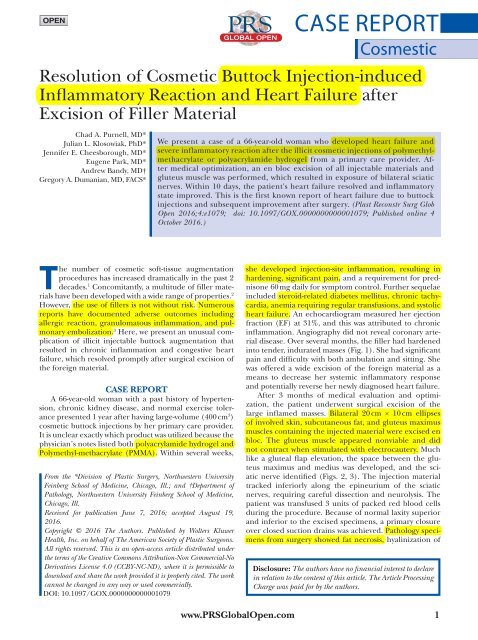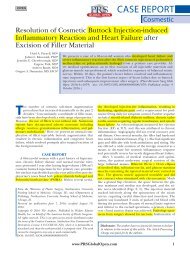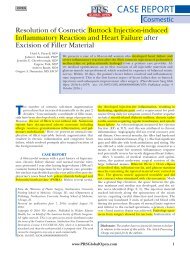PMMA
You also want an ePaper? Increase the reach of your titles
YUMPU automatically turns print PDFs into web optimized ePapers that Google loves.
Case Report<br />
Cosmestic<br />
Resolution of Cosmetic Buttock Injection-induced<br />
Inflammatory Reaction and Heart Failure after<br />
Excision of Filler Material<br />
Chad A. Purnell, MD*<br />
Julian L. Klosowiak, PhD*<br />
Jennifer E. Cheesborough, MD*<br />
Eugene Park, MD*<br />
Andrew Bandy, MD†<br />
Gregory A. Dumanian, MD, FACS*<br />
We present a case of a 66-year-old woman who developed heart failure and<br />
severe inflammatory reaction after the illicit cosmetic injections of polymethylmethacrylate<br />
or polyacrylamide hydrogel from a primary care provider. After<br />
medical optimization, an en bloc excision of all injectable materials and<br />
gluteus muscle was performed, which resulted in exposure of bilateral sciatic<br />
nerves. Within 10 days, the patient's heart failure resolved and inflammatory<br />
state improved. This is the first known report of heart failure due to buttock<br />
injections and subsequent improvement after surgery. (Plast Reconstr Surg Glob<br />
Open 2016;4:e1079; doi: 10.1097/GOX.0000000000001079; Published online 4<br />
October 2016.)<br />
The number of cosmetic soft-tissue augmentation<br />
procedures has increased dramatically in the past 2<br />
decades. 1 Concomitantly, a multitude of filler materials<br />
have been developed with a wide range of properties. 2<br />
However, the use of fillers is not without risk. Numerous<br />
reports have documented adverse outcomes including<br />
allergic reaction, granulomatous inflammation, and pulmonary<br />
embolization. 3 Here, we present an unusual complication<br />
of illicit injectable buttock augmentation that<br />
resulted in chronic inflammation and congestive heart<br />
failure, which resolved promptly after surgical excision of<br />
the foreign material.<br />
CASE REPORT<br />
A 66-year-old woman with a past history of hypertension,<br />
chronic kidney disease, and normal exercise tolerance<br />
presented 1 year after having large-volume (400 cm 3 )<br />
cosmetic buttock injections by her primary care provider.<br />
It is unclear exactly which product was utilized because the<br />
physician’s notes listed both polyacrylamide hydrogel and<br />
Polymethyl-methacrylate (<strong>PMMA</strong>). Within several weeks,<br />
From the *Division of Plastic Surgery, Northwestern University<br />
Feinberg School of Medicine, Chicago, Ill.; and †Department of<br />
Pathology, Northwestern University Feinberg School of Medicine,<br />
Chicago, Ill.<br />
Received for publication June 7, 2016; accepted August 19,<br />
2016.<br />
Copyright © 2016 The Authors. Published by Wolters Kluwer<br />
Health, Inc. on behalf of The American Society of Plastic Surgeons.<br />
All rights reserved. This is an open-access article distributed under<br />
the terms of the Creative Commons Attribution-Non Commercial-No<br />
Derivatives License 4.0 (CCBY-NC-ND), where it is permissible to<br />
download and share the work provided it is properly cited. The work<br />
cannot be changed in any way or used commercially.<br />
DOI: 10.1097/GOX.0000000000001079<br />
she developed injection-site inflammation, resulting in<br />
hardening, significant pain, and a requirement for prednisone<br />
60 mg daily for symptom control. Further sequelae<br />
included steroid-related diabetes mellitus, chronic tachycardia,<br />
anemia requiring regular transfusions, and systolic<br />
heart failure. An echocardiogram measured her ejection<br />
fraction (EF) at 31%, and this was attributed to chronic<br />
inflammation. Angiography did not reveal coronary arterial<br />
disease. Over several months, the filler had hardened<br />
into tender, indurated masses (Fig. 1). She had significant<br />
pain and difficulty with both ambulation and sitting. She<br />
was offered a wide excision of the foreign material as a<br />
means to decrease her systemic inflammatory response<br />
and potentially reverse her newly diagnosed heart failure.<br />
After 3 months of medical evaluation and optimization,<br />
the patient underwent surgical excision of the<br />
large inflamed masses. Bilateral 20 cm × 10 cm ellipses<br />
of involved skin, subcutaneous fat, and gluteus maximus<br />
muscles containing the injected material were excised en<br />
bloc. The gluteus muscle appeared nonviable and did<br />
not contract when stimulated with electrocautery. Much<br />
like a gluteal flap elevation, the space between the gluteus<br />
maximus and medius was developed, and the sciatic<br />
nerve identified (Figs. 2, 3). The injection material<br />
tracked inferiorly along the epineurium of the sciatic<br />
nerves, requiring careful dissection and neurolysis. The<br />
patient was transfused 3 units of packed red blood cells<br />
during the procedure. Because of normal laxity superior<br />
and inferior to the excised specimens, a primary closure<br />
over closed suction drains was achieved. Pathology specimens<br />
from surgery showed fat necrosis, hyalinization of<br />
Disclosure: The authors have no financial interest to declare<br />
in relation to the content of this article. The Article Processing<br />
Charge was paid for by the authors.<br />
www.PRSGlobalOpen.com 1
PRS Global Open • 2016<br />
Fig. 1. Hyperpigmented, indurated lesions in bilateral buttocks 1<br />
year after soft-tissue filler injections for buttock augmentation.<br />
Fig. 3. Dissection of left buttock after removal of inflamed tissue<br />
with resultant exposure of the sciatic nerve (highlighted by the hemostat),<br />
which required careful dissection and neurolysis.<br />
Fig. 2. Gross specimen of skin, subcutaneous fat, and gluteus maximus<br />
muscle and injected material measuring 20 cm × 10 cm excised<br />
en bloc.<br />
soft tissues, dystrophic calcification, and foreign body giant<br />
cell reaction (Fig. 4).<br />
The patient was maintained as an inpatient for 11<br />
days postoperatively on an air-fluidized bed with a sitting<br />
protocol begun on postoperative day (POD) 4. Her pain<br />
diminished significantly after surgery and tachycardia resolved<br />
almost immediately. She began to walk with assistance<br />
on POD 7. Echocardiogram on POD 10 showed a<br />
complete resolution of heart failure with an EF of 56%.<br />
Leukocyte count decreased from 20,000 to 7,800 cells per<br />
microliter and corticosteroids were tapered. Her postoperative<br />
course was complicated by a mild wound infection,<br />
seroma, and grade 2 sacral pressure sore. Repeat echocardiogram<br />
on POD 72 revealed a maintained EF of 64%.<br />
DISCUSSION<br />
The burden of harm from injectable fillers offered by<br />
untrained or unlicensed providers is likely significantly<br />
Fig. 4. Microscopic section with predominantly vacuolated morphology<br />
consistent with foreign material, giant cell reaction, fat necrosis,<br />
and foci of calcifications.<br />
underreported. 4 In this case report, a patient developed<br />
an exuberant inflammatory reaction after large-volume<br />
buttock injections from a primary care provider. Although<br />
both polyacrylamide gel and <strong>PMMA</strong> in various forms have<br />
been approved for over 20 years as dermal fillers, neither<br />
of these products is FDA approved for buttock injections<br />
in the United States. Data regarding large-volume injection<br />
of fillers for buttock augmentation are essentially unavailable<br />
for this off-label use.<br />
Large studies of polyacrylamide and <strong>PMMA</strong> for facial<br />
rejuvenation have demonstrated positive esthetic<br />
results with minor complications ranging from 2.2% to<br />
15.9%. 5, 6 However, both materials have been associated<br />
2
Purnell et al. • Heart Failure due to Buttock Injections<br />
with significant inflammatory reactions. Christensen et<br />
al 7 reported a volume-dependent inflammatory reaction<br />
to polyacrylamide injection for breast augmentation;<br />
histological analysis showed that large volumes were associated<br />
with foreign-body giant cell reaction. Manafi<br />
et al 8 described 98 consecutive patients presenting with<br />
complications from polyacrylamide injection, most commonly<br />
inflammation, including 9 from buttock or leg<br />
injections. In their series, all patients were treated with<br />
an incision, drainage, and irrigation; none required a<br />
radical excision. Salles et al 9 reported 32 patients with<br />
complications after cosmetic injection of <strong>PMMA</strong> in Brazil.<br />
Ten of these patients also presented with chronic inflammatory<br />
reactions, all after facial injections, whereas<br />
2 presented with pain and nodularity secondary to gluteal<br />
augmentation.<br />
In the case of an inflamed foreign material injection<br />
such as this, a staged excision with dressing changes or<br />
vacuum-assisted closure could be considered to minimize<br />
complications associated with immediate closure. However,<br />
in the above patient, this was avoided due to concerns<br />
of exposure of sciatic nerves and risk of a second anesthetic,<br />
given her cardiac status.<br />
This report represents the first case, to our knowledge,<br />
of heart failure associated with a severe inflammatory<br />
reaction to a soft-tissue filler injection, successfully<br />
reversed with surgical excision. Congestive heart failure<br />
has traditionally been viewed as a hemodynamic disorder,<br />
yet systemic inflammation has been implicated in its<br />
pathogenesis. 10 An elevated level of the proinflammatory<br />
cytokine tissue necrosis factor α (TNF-α) is one of the<br />
principal derangements seen in the setting of heart failure.<br />
11 TNF-α suppresses cardiomyocyte contractility and<br />
promotes left ventricular dysfunction 12 ; the TNF-α inhibitor<br />
etanercept demonstrated significant improvements in<br />
left ventricular EF in human clinical trials. 13 TNF-α also<br />
has a critical role in the pathogenesis of granulomatous<br />
inflammation of the kind presented here. 14 Although the<br />
mechanisms by which our patient’s congestive heart failure<br />
resolved after excision remains unclear, an appealing<br />
hypothesis entails the removal of a generator of proinflammatory<br />
cytokines that were exerting a deleterious effect<br />
on myocardial function.<br />
CONCLUSIONS<br />
We present a patient with a severe inflammatory reaction<br />
and heart failure after illicit injection of a large<br />
volume of filler for buttock augmentation. After wide excision<br />
of the filler material, the inflammatory reaction<br />
and heart failure resolved. This type of excision has a<br />
high risk of morbidity but can result in the resolution of<br />
filler-related complications. Large-volume buttock filler<br />
injections have significant potential for patient harm.<br />
Gregory A. Dumanian, MD, FACS<br />
Division of Plastic Surgery<br />
Northwestern Feinberg School of Medicine<br />
675 N St. Clair Street, Suite 19–250<br />
Chicago, IL<br />
E-mail: Gdumania@nm.org<br />
REFERENCES<br />
1. Cosmetic surgery National Data Bank: statistics 2012. Aesthet Surg<br />
J. 2013;33(2 Suppl):1S–21S.<br />
2. Kontis TC. Contemporary review of injectable facial fillers. JAMA<br />
Facial Plast Surg. 2013;15:58–64.<br />
3. Requena L, Requena C, Christensen L, et al. Adverse reactions<br />
to injectable soft tissue fillers. J Am Acad Dermatol. 2011;64:1–34;<br />
quiz 35.<br />
4. Mayer JE, Goldberg DJ. Injuries attributable to cosmetic procedures<br />
performed by unlicensed individuals in the United States.<br />
J Clin Aesthet Dermatol. 2015;8:35–37.<br />
5. Pallua N, Wolter TP. A 5-year assessment of safety and aesthetic<br />
results after facial soft-tissue augmentation with polyacrylamide<br />
hydrogel (Aquamid): a prospective multicenter study of 251 patients.<br />
Plast Reconstr Surg. 2010;125:1797–1804.<br />
6. Cohen SR, Berner CF, Busso M, et al. ArteFill: a long-lasting<br />
injectable wrinkle filler material – summary of the U.S. Food<br />
and Drug Administration trials and a progress report on 4- to<br />
5-year outcomes. Plast Reconstr Surg. 2006;118(3 Suppl):64S–<br />
76S.<br />
7. Christensen LH, Breiting VB, Aasted A, et al. Long-term effects<br />
of polyacrylamide hydrogel on human breast tissue. Plast Reconstr<br />
Surg. 2003;111:1883–1890.<br />
8. Manafi A, Emami AH, Pooli AH, et al. Unacceptable results with<br />
an accepted soft tissue filler: polyacrylamide hydrogel. Aesthetic<br />
Plast Surg. 2010;34:413–422.<br />
9. Salles AG, Lotierzo PH, Gemperli R, et al. Complications after<br />
polymethylmethacrylate injections: report of 32 cases. Plast<br />
Reconstr Surg. 2008;121:1811–1820.<br />
10. Seta Y, Shan K, Bozkurt B, et al. Basic mechanisms in heart failure:<br />
the cytokine hypothesis. J Card Fail. 1996;2:243–249.<br />
11. Blum A, Miller H. Role of cytokines in heart failure. Am Heart J.<br />
1998;135(2 Pt 1):181–186.<br />
12. Pagani FD, Baker LS, Hsi C, et al. Left ventricular systolic and diastolic<br />
dysfunction after infusion of tumor necrosis factor-alpha<br />
in conscious dogs. J Clin Invest. 1992;90:389–398.<br />
13. Bozkurt B, Torre-Amione G, Warren MS, et al. Results of targeted<br />
anti-tumor necrosis factor therapy with etanercept<br />
(ENBREL) in patients with advanced heart failure. Circulation<br />
2001;103:1044–1047.<br />
14. Amiri P, Locksley RM, Parslow TG, et al. Tumour necrosis factor<br />
alpha restores granulomas and induces parasite egg-laying in<br />
schistosome-infected SCID mice. Nature 1992;356:604–607.<br />
3




